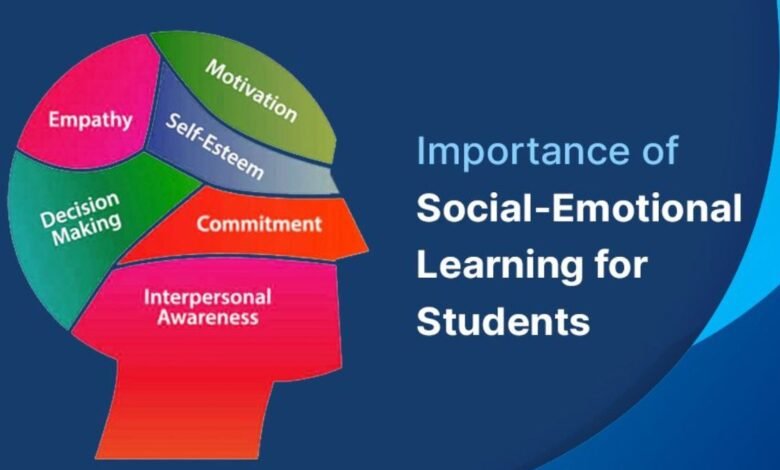The Role of Social-Emotional Learning in Education

Education is no longer limited to academic achievement; it encompasses a holistic development of students. One of the most significant advancements in modern education is the inclusion of Social-Emotional Learning (SEL). SEL is a comprehensive approach that focuses on students’ emotional and social development alongside traditional academic skills. This method fosters emotional intelligence, social skills, and resilience, preparing students to navigate the complexities of life both in and out of the classroom. The role of Social-Emotional Learning in education has become crucial as schools recognize the importance of nurturing students’ emotional well-being and interpersonal skills.
What is Social-Emotional Learning (SEL)?
At its core, Social-Emotional Learning refers to the process through which individuals develop essential emotional and social competencies. The Collaborative for Academic, Social, and Emotional Learning (CASEL), one of the leading organizations in promoting SEL, identifies five core competencies: self-awareness, self-management, social awareness, relationship skills, and responsible decision-making.
- Self-awareness involves recognizing one’s emotions, values, and strengths. It helps individuals understand their feelings and how those feelings influence behavior.
- Self-management refers to regulating emotions, managing stress, and setting and achieving personal goals. It encourages self-discipline and perseverance.
- Social awareness encompasses empathy, understanding diverse perspectives, and recognizing social cues. This competency fosters compassion and inclusivity.
- Relationship skills include effective communication, cooperation, conflict resolution, and building strong interpersonal relationships. Students learn how to work collaboratively and maintain healthy social interactions.
- Responsible decision-making focuses on making ethical, constructive choices about personal and social behavior. It involves weighing consequences and considering the well-being of others.
SEL promotes a safe, inclusive, and supportive learning environment. By teaching students these competencies, educators aim to develop individuals who are emotionally intelligent, socially responsible, and better equipped to face life’s challenges.
The Importance of SEL in the Modern Educational Landscape
The inclusion of Social-Emotional Learning in education addresses several critical needs in today’s society. With increasing concerns about student mental health, social isolation, and stress, SEL provides a framework for improving emotional well-being and creating a more positive school climate.
One of the primary reasons for integrating SEL is the rise in mental health issues among students. According to research, 1 in 5 children and adolescents experience mental health problems, ranging from anxiety to depression. In many cases, these emotional challenges go unnoticed or untreated, affecting students’ academic performance and overall well-being. SEL helps mitigate these issues by teaching students how to recognize their emotions, cope with stress, and develop resilience.
Moreover, SEL fosters a positive school culture. When students feel emotionally supported and safe, they are more likely to engage in learning, participate in discussions, and collaborate with peers. Schools that implement SEL programs often report lower rates of bullying, improved peer relationships, and enhanced student-teacher interactions. SEL helps reduce conflict and fosters a sense of community, creating a more conducive environment for learning.
In today’s world, where social media and digital communication dominate, SEL also teaches critical interpersonal skills that are often neglected. Students learn the value of empathy, active listening, and non-verbal communication, which are vital for building meaningful relationships. In a digital age where face-to-face interactions are less frequent, these skills become even more important.
The Academic Impact of SEL
Although SEL primarily focuses on emotional and social development, its benefits extend to academic achievement. A meta-analysis of 213 studies by CASEL revealed that students who participate in SEL programs show an 11% increase in academic performance compared to those who do not. This improvement is attributed to the emotional regulation and focus that SEL cultivates, allowing students to concentrate better on their studies.
Students who possess strong social-emotional skills are better equipped to handle academic challenges. For instance, self-management skills enable students to stay organized, manage time effectively, and persevere through difficult tasks. Relationship skills foster collaboration in group projects, while responsible decision-making encourages ethical behavior, such as honesty during exams and respect for classroom rules.
Moreover, SEL teaches students how to handle failure and setbacks. In the face of academic pressure, students often feel discouraged when they encounter challenges. SEL helps students develop a growth mindset, where they view mistakes as learning opportunities rather than failures. This shift in mindset enhances resilience, enabling students to bounce back from academic disappointments and continue striving for success.
SEL’s Role in Reducing Behavioral Issues
Behavioral issues, such as aggression, defiance, and disruption, can negatively impact the learning environment. SEL has been proven to reduce such problems by fostering self-regulation and empathy among students. When students learn to recognize and manage their emotions, they are less likely to act out impulsively. They also become more empathetic toward their peers, reducing conflicts and promoting peaceful resolution.
Several studies have demonstrated that SEL programs lead to a significant reduction in disciplinary incidents. Schools that prioritize SEL report fewer suspensions, expulsions, and behavioral referrals. This reduction not only improves the school climate but also allows teachers to focus more on instruction rather than managing disruptive behavior.
Additionally, SEL equips students with problem-solving skills that help them navigate interpersonal conflicts. By teaching students how to communicate effectively and understand others’ perspectives, SEL reduces misunderstandings and promotes harmony within the classroom. As students develop these skills, they are more likely to resolve conflicts independently and maturely.
The Role of Teachers in Implementing SEL
Teachers play a crucial role in the successful implementation of Social-Emotional Learning. They are not only responsible for teaching academic content but also for modeling social-emotional skills. Teachers who practice empathy, active listening, and emotional regulation serve as role models for their students.
To effectively implement SEL, teachers must create a supportive and inclusive classroom environment. This involves setting clear expectations, encouraging open communication, and fostering a sense of belonging. Teachers can integrate SEL into daily routines by incorporating activities such as mindfulness exercises, group discussions, and collaborative projects that emphasize empathy and teamwork.
Moreover, teachers should receive adequate training in SEL to feel confident in teaching these skills. Professional development programs focused on SEL can equip teachers with strategies for promoting emotional intelligence and addressing students’ social-emotional needs. When teachers are well-prepared, they are more likely to create a positive impact on students’ social-emotional development.
SEL Beyond the Classroom: Involving Families and Communities
While schools play a critical role in fostering SEL, the support of families and communities is equally important. Parents and caregivers can reinforce social-emotional skills at home by encouraging open dialogue, teaching empathy, and providing emotional support. When families and schools work together, students receive consistent messages about the importance of emotional well-being and social skills.
Communities can also contribute to SEL by providing extracurricular programs, mentoring opportunities, and safe spaces for students to practice social-emotional skills. Programs such as sports teams, arts clubs, and volunteer organizations offer valuable opportunities for students to collaborate, communicate, and develop leadership skills.
Furthermore, community partnerships can help schools access additional resources for SEL, such as counseling services, mental health support, and workshops on emotional regulation. When students see that their emotional well-being is prioritized both in and out of school, they are more likely to develop strong social-emotional competencies.
The Long-Term Benefits of SEL
The benefits of Social-Emotional Learning extend far beyond the classroom. As students develop emotional intelligence and social skills, they become better prepared for the demands of adulthood. SEL fosters qualities such as resilience, empathy, and responsible decision-making, which are essential for success in personal and professional life.
Research shows that individuals with strong social-emotional skills are more likely to excel in the workplace, maintain healthy relationships, and contribute positively to society. Employers increasingly value emotional intelligence, collaboration, and communication skills in their employees. By teaching these competencies at a young age, SEL prepares students for the workforce and equips them with the tools they need to thrive in diverse environments.
Additionally, SEL promotes lifelong mental health and well-being. Individuals who can manage stress, navigate social relationships, and make responsible decisions are more likely to lead fulfilling lives. SEL empowers students to take charge of their emotional well-being and fosters a sense of self-efficacy that contributes to long-term happiness.
Conclusion
Social-Emotional Learning plays a vital role in education by fostering emotional intelligence, social skills, and resilience. As schools increasingly recognize the importance of students’ emotional well-being, SEL has become an essential component of modern education. Its benefits extend to academic achievement, behavioral improvement, and long-term personal success. By prioritizing SEL, schools, families, and communities can work together to ensure that students are not only academically prepared but also emotionally equipped to face the challenges of life.



